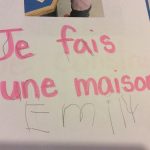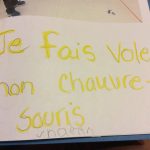We used photo documentation of the learning in the classroom to create class books of class learning and activities with students. We co-constructed the descriptions with students, using student-friendly vocabulary and sight words, to support our oral, reading and writing development in French. By sharing our experiences, learning and ideas with others through our class books, we had evidence of growth in learning for evaluation throughout the year, as well as documentation to share with parents about the learning activities in the classroom written by the students. This project allowed students and educators the opportunity to engage in meaningful conversations about learning and achievement by naming and noticing the learning for and with students, as well as engage in meaningful vocabulary development with individual students.
Team Members
Lorie Fulford-Mason
Renfrew County District School Board
Jennifer Vaillancourt
Renfrew County District School Board
Professional Learning Goals
By engaging in professional readings and discussions as a team, the kindergarten educators were able to deepen their understanding of the different types of pedagogical documentation. We also engaged in discussions with other education professionals (SERT, consultants, student success teacher, principal) to further develop our understanding.
We became more effective at analyzing our documentation to help support student learning and growth in the kindergarten curriculum, as well as use this information (along with our anecdotal notes) to plan for future learning and groupings. We also noted that having photos of the process and completed student work provided us with a different perspective and often provided more insight into the learning and next steps that we missed in the moment.
We were able to try different ways of using these books to engage and inform parents of the work in the classroom by sharing photos of the work, copies of our book pages electronically and having copies accessible when parents came to visit the school.
Activities and Resources
To begin, we each read the book Pedagogical Documentation in Early Childhood: Sharing Children’s Learning And Teachers’ Thinking to deepen our understanding of the different types of pedagogical documentation and discuss what might work best for us. We also used the Ministry of Ontario monograph Pedagogical Documentation Revisited to support our conversations.
We used the kindergarten curriculum expectations and Growing Success: The Kindergarten Addendum to develop our Learning Goals and Success Criteria (“Look Fors”) to help narrow our focus for the types of photographs we wanted to take to help guide our discussions with students (e.g., focusing on particular math learning).
We took many photos of student learning (both educator- and student-initiated) so each student would have a few photos to choose from when doing their writing.
This activity provided meaningful ways for students to practise their letter formation, letter identification, letter-sound relationships, stretching out words and practising our French sight words (based on student readiness).
We also purchased headphones with built-in microphones to help students write independently using an iPad and Google Drive.
Unexpected Challenges
We did not anticipate the significant time that would be required to support each student’s ability to complete a sentence for their photo. Due to the fact that we are working in the students’ second language, there were lots of discussions and knowledge shared before the student was able to write their sentence, which resulted in our books taking much longer to complete than expected. We did purchase headphones with built-in microphones as a way to use technology to help some students work independently.
Our school (and classroom) was also involved in a number of board projects, so we found it difficult to take time out of the classroom to engage in the project so we often took time before and after school to engage in our discussions as a team.
Enhancing Student Learning and Development
Using classroom photos of student work and learning provided a meaningful writing task for our students, and most were engaged in what they were writing and were proud to share their work. By compiling these writings into class books, the students were also interested in reading about the other photos.
Taking the time to work with each student individually provided the educators an opportunity to work on one or two writing goals and provide very specific guidance to each student, which could transfer to their other writing tasks and activities.
Sharing
We have had the opportunity to share our project work with the other two kindergarten teams at our school during a staff meeting. We shared our resources (the book and Ministry monograph), explained our process and shared examples of the end product from our students.
We also purchased extra headphones with built-in microphones to share with other kindergarten teams who would like to try using them for writing in their classrooms (along with the iPads we have all been provided for classroom use). We plan to share a description of our project, via email, with other kindergarten teams in our school board and offer to loan resources to help them. We will create a kit that includes the book Pedagogical Documentation in Early Childhood: Sharing Children’s Learning And Teachers’ Thinking, the Ministry of Ontario monograph Pedagogical Documentation Revisited, sample pages of student work (from students working at various stages of writing), and a pair of headphones with built-in microphones.
Project Evaluation
The project provided us with the support we needed to take time to engage in professional dialogues as a team and with other professionals in order to develop our understanding and confidence with regards to pedagogical documentation. We both feel much more knowledgeable about the different types of pedagogical documentation and our ability to assess what would work best for different purposes. One thing I think we might do differently is take some time to become more familiar with the different types of pedagogical documentation before jumping into our documentation. We felt overwhelmed at the beginning when we tried to start our writing while still engaging in our readings.
We have noticed that our ability to analyze our documentation has improved. In the past, we had an incredible number of pictures of our students and their work, but we had not been able to assess what we might be looking for (to demonstrate student learning of curriculum expectations) and take photos (and videos) of that type of work. We have also become more familiar with the new curriculum and can see the expectations come alive in the classroom much more effectively to capture authentic student learning.
We were also able to use these pieces of student work to engage parents in the activities in the classroom. In the past, we have had many parents say they wished they were able to come into the classroom and volunteer to experience the activities first-hand. By sharing these writing pieces about the learning in the classroom, we found that parents felt more connected to the classroom and aware of the learning their children were doing than reading about it in a classroom newsletter. We received many positive comments from parents about these writing tasks when they were shared.
Resources Used
K-12 Capacity Building Series Pedagogical Documentation Revisited by Ontario Ministry of Education (January 2015)
http://www.edu.gov.on.ca/eng/literacynumeracy/inspire/research/CBS_PedagogicalDocument.pdf
Pedagogical Documentation in Early Childhood: Sharing Children’s Learning and Teachers’ Thinking” by Susan Stacey (April 2015)
Pedagogical Documentation in Early Childhood is an inspiring step-by-step guide to documenting children’s ideas, questions, play and learning in a way that enhances teachers’ thinking and understanding at the same time. This book supports teachers on their journey to tell the stories behind children’s work and inquiry.
The Kindergarten Program (2016)
Growing Success: The Kindergarten Addendum
http://www.edu.gov.on.ca/eng/policyfunding/growingSuccessAddendum.pdf
Resources Created
These resources will open in your browser in a new tab, or be downloaded to your computer.



